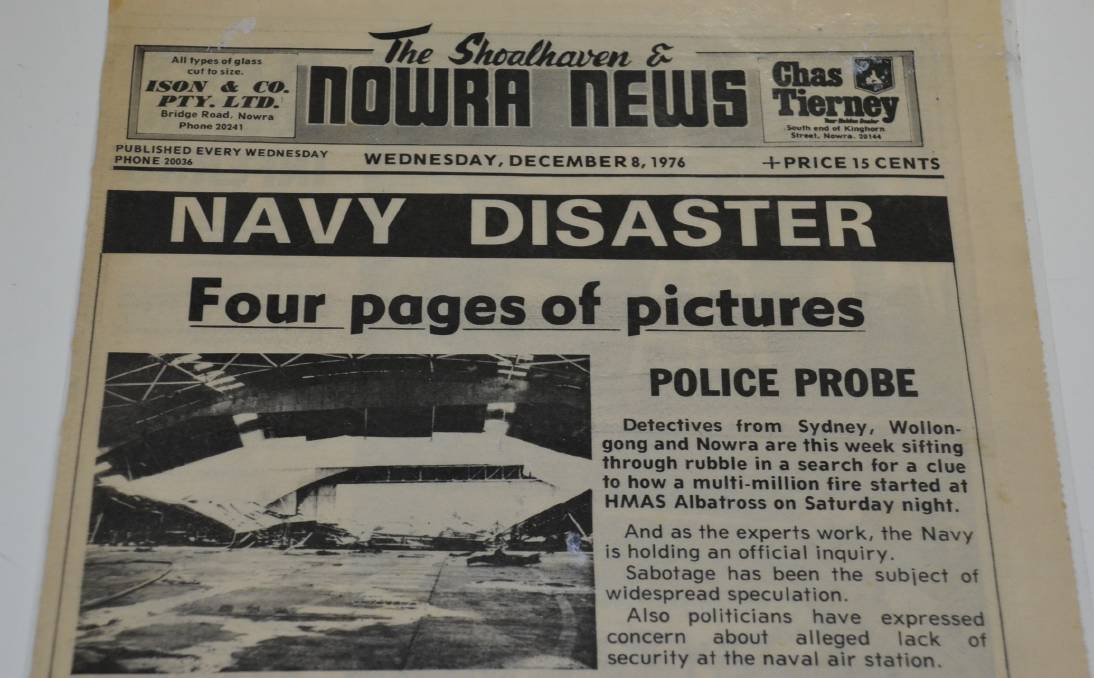LAST Sunday marked 40 years since one of the biggest disasters ever to strike HMAS Albatross and one of the biggest fires ever witnessed in the area.
On December 4, 1976 a hanger, home to 12 Grumman Tracker aircraft was intentionally set on fire, destroying all but three aircraft.
Six were totally destroyed, three were damaged beyond repair. Two were capable of repair and were returned to service, while one was at the Hawker de Havilland workshops in Bankstown at the time, undergoing inspection.
At the time the Shoalhaven and Nowra News declared it a “Naval disaster”
For both Tracker squadrons, VC851 and VS816, it was a major setback.
The fire started around 11.30pm in 'H' hangar. The Trackers had been stowed close together for security and shared resources reasons. A navy report said they all had their tanks fully loaded with volatile aviation fuel to avoid water contamination from condensation forming in the fuel tanks over the upcoming Christmas period.
Around 100 Albatross personnel and local Nowra firefighters battled the blaze which took many hours to extinguish.
Six of the aircraft were dragged from the hanger, with in some cases naval personnel using their own vehicles to do so. Ropes were attached to tailhooks and the aircraft were dragged clear of the burning hanger.
The roof on the northern half of the hanger collapsed to the floor, trapping the remaining six aircraft, with fire severely damaged the southern half of the building.
It was later discovered the automatic water sprinklers had been turned off and two of the aircraft had had defuelling valves open, allowing highly flammable Avgas to leak all over the hanger floor.
A pair of chrome-plated electrical cutters used to cut the leather strap that normally restrained the spinkler valve in the open position, were found in the sprinkler control room.
A fingerprint found on the tool was later used to identify an offender.
On January 19, 1977, a 19-year-old junior sailor Graham John Trent from 851 Squadron admitted to starting the fire. He was subsequently found to be mentally unstable at his court-martial.
Eric Woolley who served with the Nowra Fire Brigade for 37 years, and eventually became brigade captain, said it was the biggest fire he ever attended.
“I certainly remember that fire,” he said.
“It was the biggest fire the NSW Fire Brigade ever attended on a naval or defence force establishment.
“When we got there naval personnel were running around trying to do their best to put the fire out.
“The roof had already collapsed onto the Trackers and they were spraying water onto the roof.
“We had to take the assault to the fire and get inside. We were told it was impossible all the doors were locked.
“I went to one end where there was a big hanger door and gave it an almighty shove and it moved about a foot and we were able to get in.
“I vividly remember the first thing I saw was a melted Tracker propeller right in front of me.
“When the fire was all out, the captain in charge asked what we would like as a memento and I said that melted propeller. It hung in the Nowra Town Brigade’s building for many years.”
He said it wasn’t until some time after they were alerted to the fact the fire had been deliberately lit.
“It wasn’t until later that we heard about the fuel lines being open and that explained the intensity of the fire, why it was so hot. There was fuel all over the place,” he said.
“The fuel was leaking and running everywhere - we used foam to try and stop it. It was a fair while until we managed to get it under control.
“Because there was so much fuel around, the planes they did manage to get outside would also catch fire, so we had a hanger on fire and aircraft outside on fire.”
Mr Woolley, who attended some of the area’s biggest fires including the ones that destroyed the John Bull Rubber Factory at Bomaderry (1985) and Advanx Westwood Tyre fire in Nowra (1966), said while those fires were both big blazes, in terms of monetary damage the HMAS Albatross fire was the biggest.
“The word was the fire cost around $50 million,” he said.
Mick Ison was deputy captain of the Nowra brigade at the time and remembers the fire vividly.
“I recall Captain Joe Hyam was away so the call came through to our place,” he said.
“We were initially told there was a tractor on fire.
“As we were driving past Keystone Valve on Albatross Road, I looked at the amount of smoke and said to Eric Woolley and Peter Murphy who were in the truck, by Christ it must be a big tractor!
“It wasn’t until we got there we discovered it was a hanger with Tracker aircraft inside.
“It turned out to be the most expensive commercial fire in Australia’s history. It may still be today?
“The biggest fire I ever went too.
“Considering it was fully alight when we got there I think we did a pretty good job.”
The fire cut the RAN Tracker fleet almost in half. Six trackers already on order were fast tracked from the US with an order placed for an additional 10 aircraft. Replacements were sort from the US from the Davis-Monthan US Air Force Base in the Arizona desert where they were stored for preservation. Sixteen aircraft were finally selected. In less than six months the fixed wing component of RAN naval aviation had been destroyed and resurrected with a better than ever capability.
Information gathered from HMAS Albatross A Collection of Memories and Flying Stations A Story of Australian Naval Aviation.



